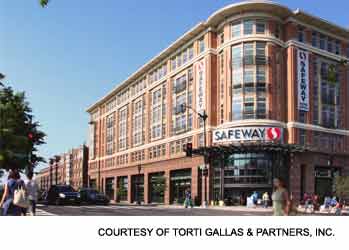Seeking LEED Certification in Retail Spaces
First of a 3-part article on how retailers are using LEED and other resources to prioritize sustainability and go green
Despite the growth of e-commerce, physical retail locations are not going the way of the fax machine anytime soon: Retail and mall space still encompass 20 percent of U.S. buildings. In this highly competitive market, where margins are often thin and consumers enjoy a wealth of choices, an increasing number of retail owners are turning to sustainability to differentiate themselves while improving their operational efficiencies. A 2014 study says the number of retail owners highly involved in green building (where more than half of their new buildings are green) more than doubled between 2011 and 2013 from 18 to 38 percent and is expected to grow to more than 50 percent by 2016. Seeking a LEED certification for retail spaces, however, still presents challenges: The wide variety of store types and uses makes it hard to determine a one-size-fits-all solution, and the relationship between what the retail tenant controls versus the landlord in a shopping mall setting means that parties with different interests may need to collaborate for success.
Highly Involved Owners
What are these “highly involved” owners profiled in the study (titled “LEED in Motion: Retail,” U.S. Green Building Council) doing differently to successfully implement LEED strategies into their stores and reap the benefits of a better performing real estate portfolio? The following are a few smart and sensible methods to ensure success.
By understanding the company’s underlying values and goals first, those values can then be translated to guide implementation and align delivery of LEED strategies. For example, one company may be more driven to achieve operational efficiency of the building, whereas another may be more invested in ensuring employee health, comfort, and productivity.
This cohesion between the larger company mission and LEED criteria guides actions to support sustainability throughout the company’s operations. These values can manifest themselves in a corporate sustainability plan or other written mission statement that directs how responsible actions are to be executed in retail space, including daily operations, the leasing process, and top-level executive decision-making.
And the results can be found at the retailer and developer scales. For example, Target’s corporate responsibility plan includes a specific commitment to sustainability. Beyond just offering green products, Target aligns values to action, by choosing to develop its properties in efficient locations, including leasing in previously constructed sites and choosing locations near urban sites. The company further reduces the environmental impact of new development through stormwater management efforts, energy efficiency, and the sourcing of power from renewable sources like on-site solar atop its buildings. Roughly a quarter of Target stores are located in previously developed spaces, while the newly built San Rafael, Calif., store is LEED Gold certified.
Retail developers are also demonstrating their core values through tangible and visible development features. For example, certain retail developers may include site and landscape features to distinguish a development from its neighbors and provide the visitor with a unique experience. Similarly, many retail developers recognize the operational benefits (financial and maintenance) they achieve by updating to LED lighting, including sophisticated lighting controls and programmed sequences.
To ensure that the impact of these sustainable upgrades and practices are fully leveraged and don’t simply end at the core and shell development phase, many developers are choosing to engage in new types of partnerships with their tenants.
Related Topics:














